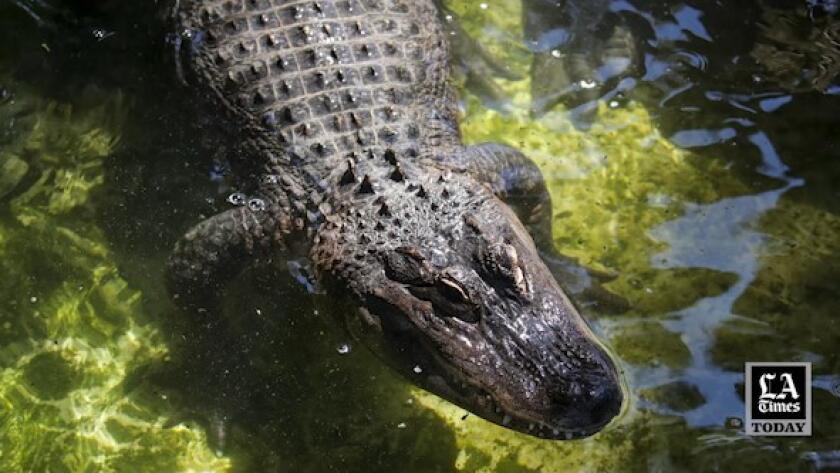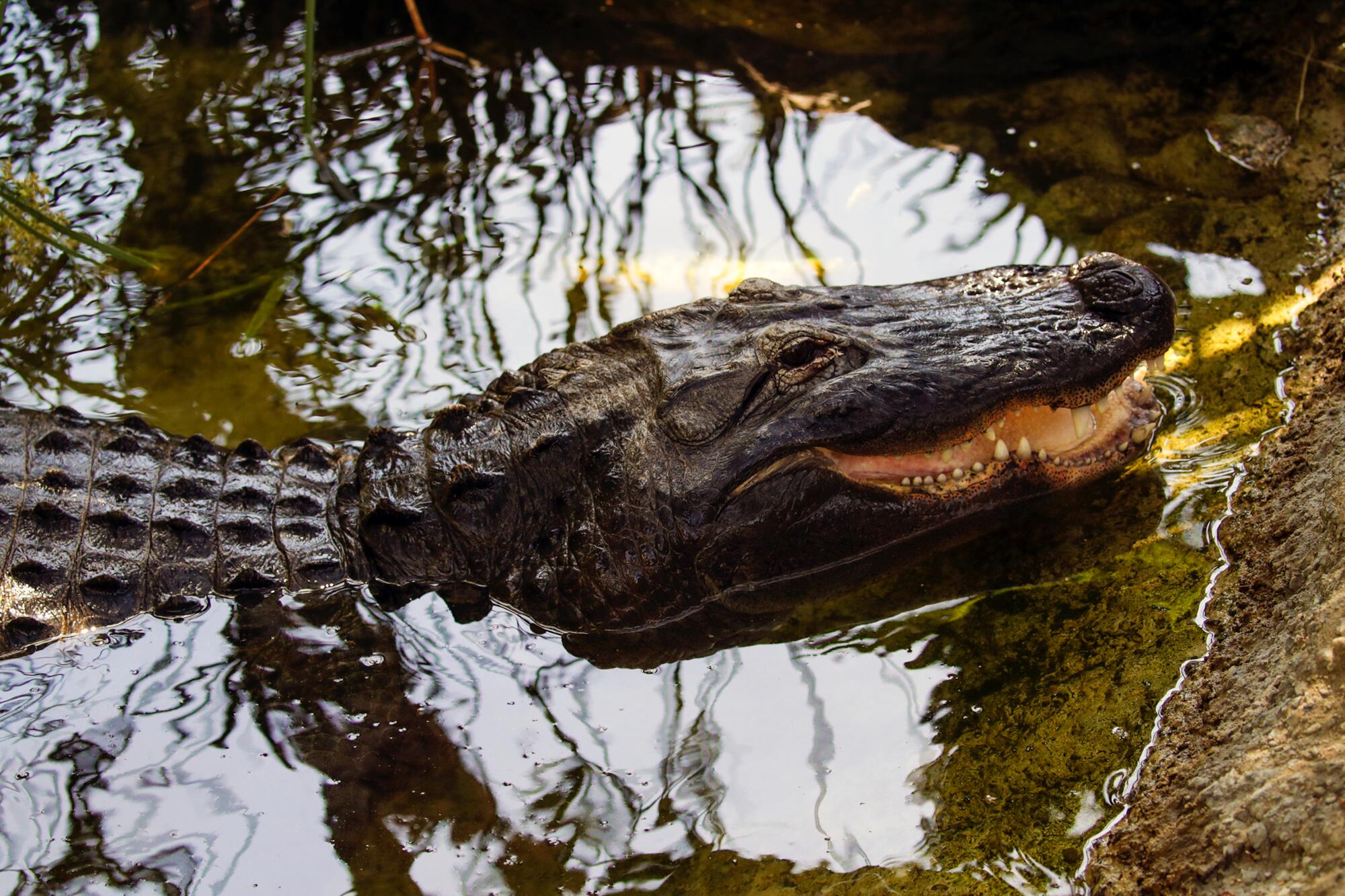
Reggie, the most famous alligator in Los Angeles, lives in a beautifully landscaped midcentury dwelling just outside Los Feliz. When it’s sunny, he swims in his pool. When it’s chilly, he doesn’t do much of anything. He lives companionably with a female named Tina, and if you think it’s easy for two alligators to pair up later in life without trying to bite each other’s limbs off, well, you don’t know a lot about alligators.
Between the two fences that separate Reggie’s enclosure from the public is a sign with the thumbnail version of his remarkable journey to the Los Angeles Zoo 15 years ago today. Some visitors stop to read it; a lot of them don’t. But once upon a time — before P-22, before Grumpy Cat and Doug the Pug — people gathered by the hundreds just to catch a glimpse of the celebrity gator.
You could buy T-shirts emblazoned with Reggie’s likeness. His name appeared in headlines from Long Beach to London. A decent chunk of L.A.’s budget — $180,000 — went to Reggie-related expenses.
What Reggie makes of his unusual life story is a mystery. An alligator brain is the size of a peanut.
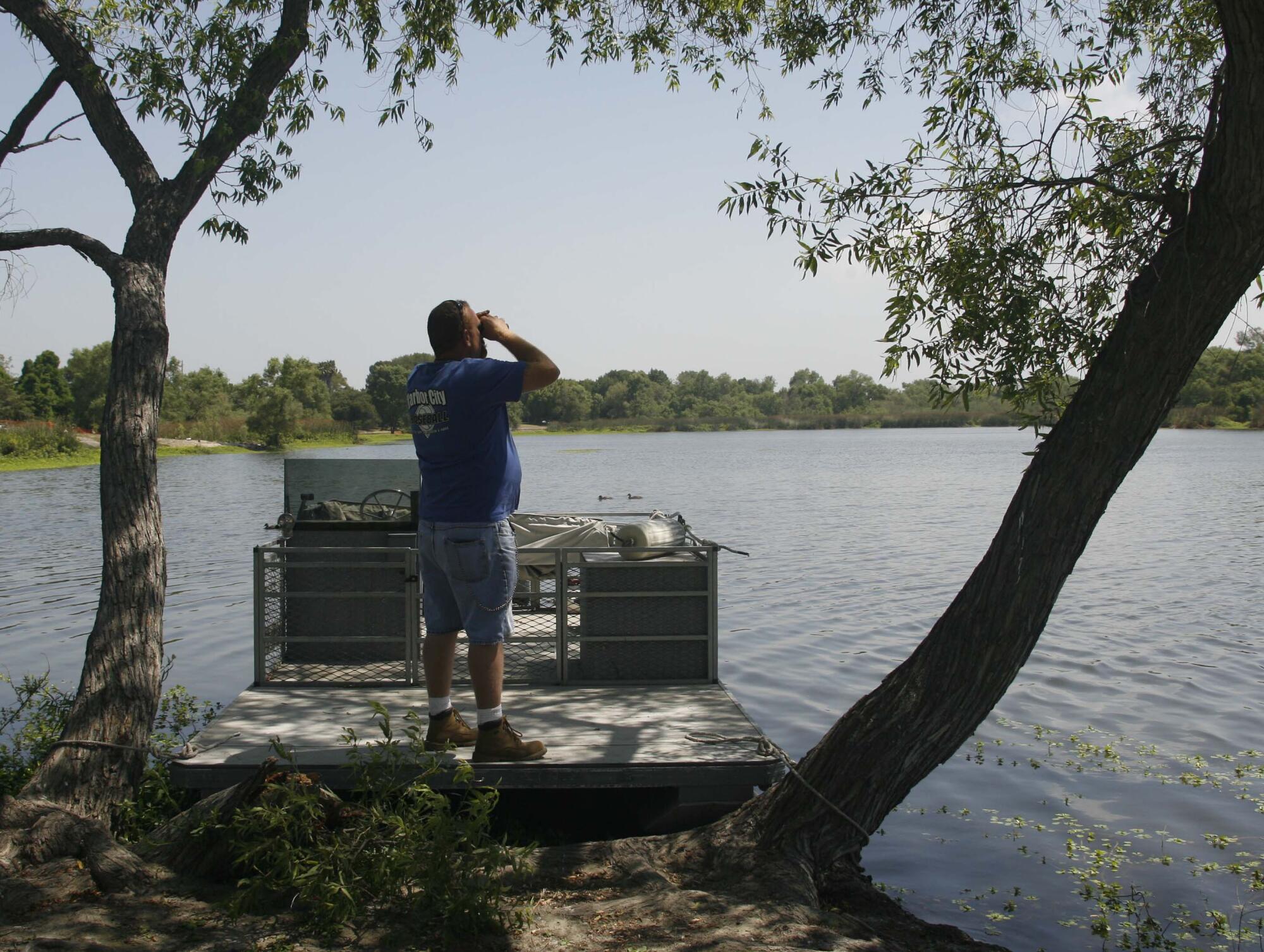
A gator emerges
Lake Machado today is the attractive center of Ken Malloy Harbor Regional Park in Harbor City, a haven for birds and native plants. But in the summer of 2005, the lake was a polluted watering hole, encircled with overgrown vegetation and teeming with frogs, birds and carp.
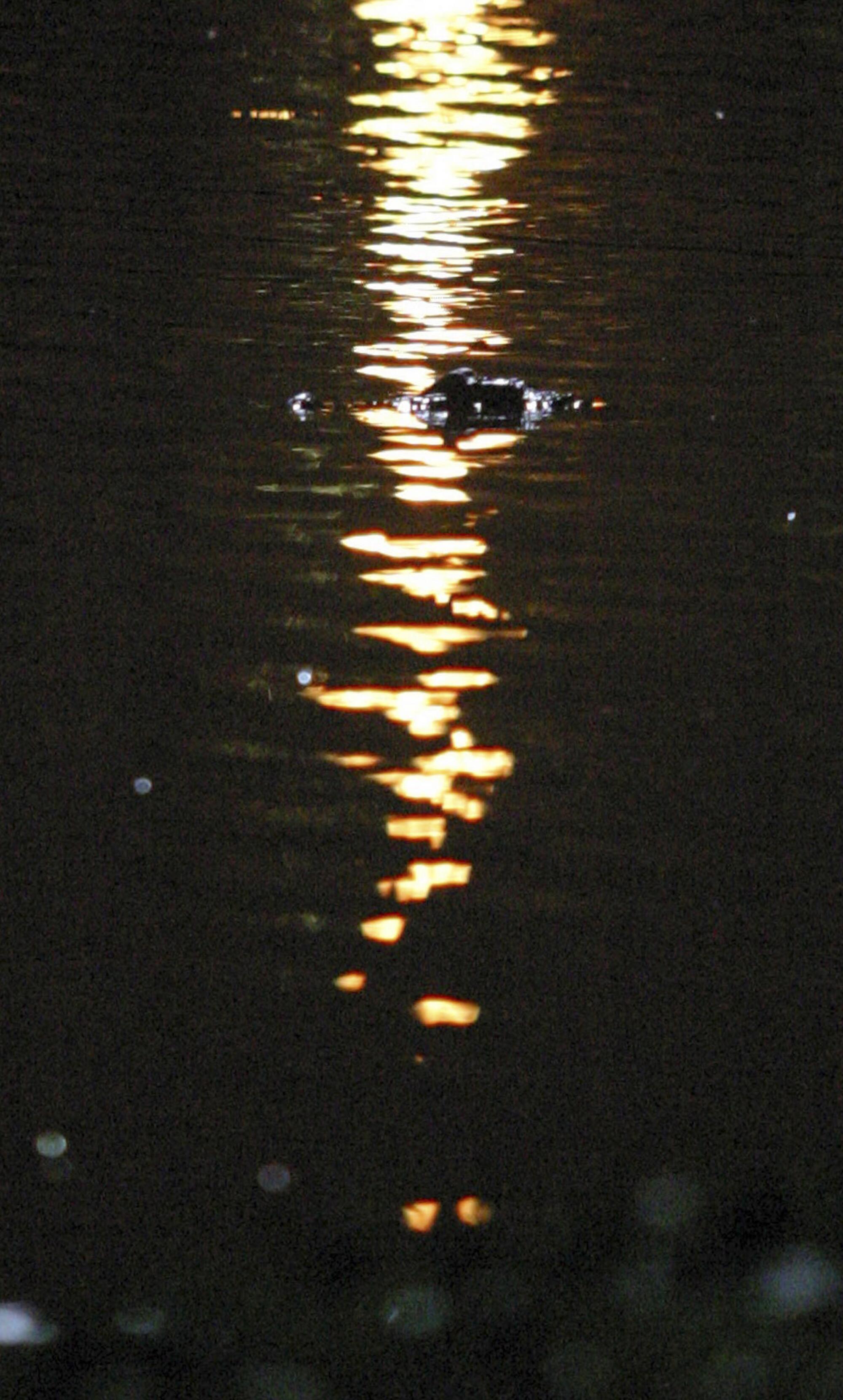
There is no good place in Los Angeles to set an alligator free. That said, Lake Machado at that time was not the worst place to do it. Reggie was placed there by two reptile enthusiasts who’d raised him in their San Pedro homes, alongside snapping turtles, piranhas, rattlesnakes and desert tortoises.
Pet alligators are illegal in California, but they’re not hard to come by. Hatchlings have big eyes, snubby little snouts and can fit in the palm of your hand.
A 10-year-old American alligator, on the other hand, can be 6 feet long and strong enough to bite through bone.
Somewhere in between is when a lot of exotic pet owners reach the same conclusion that Reggie’s former handlers did: The gator had to go.
Alligators, though, are nothing if not survivors.
Crocodilian reptiles appeared on the planet alongside dinosaurs some 95 million years ago and have hung on ever since. Fossils show that the form of the American alligator (Alligator mississippiensis) has remained virtually unchanged in the last 8 million years, as if it had simply opted out of evolution.
Gators are the semiaquatic equivalent of coyotes, said Ian Recchio, the zoo’s reptile curator: canny, omnivorous, adept at snatching food and avoiding predators.
“It almost became a circus-like atmosphere. Particularly in the evening when Reggie could be seen poking his head out of the lake, they would bring lawn chairs and blankets.”
— Supervisor Janice Hahn, then a city councilwoman representing Harbor City
Rumors of an alligator-like figure surfacing in the lake began to swirl around Harbor City. This was a year and a half before the iPhone, and photographic evidence was scarce. Claims of a wild swamp-dwelling reptile living a mile from the 110 seemed fantastical.
Then on Aug. 12, a teenage Reggie crawled out of the water for a sunbath, and a city lost its mind.
Chaos ensues
Park employees quickly built a fence around the lake. After that, no one really seemed sure what to do.
Curious crowds gathered at the park. The longer Reggie remained on the loose, the more people came. English-speaking fans nicknamed the alligator Harry; Spanish speakers called him Carlito. People hurled offerings of food over the fence: marshmallows, raw chicken, tortillas. Vendors patrolled the crowd with custom-designed T-shirts and snacks.
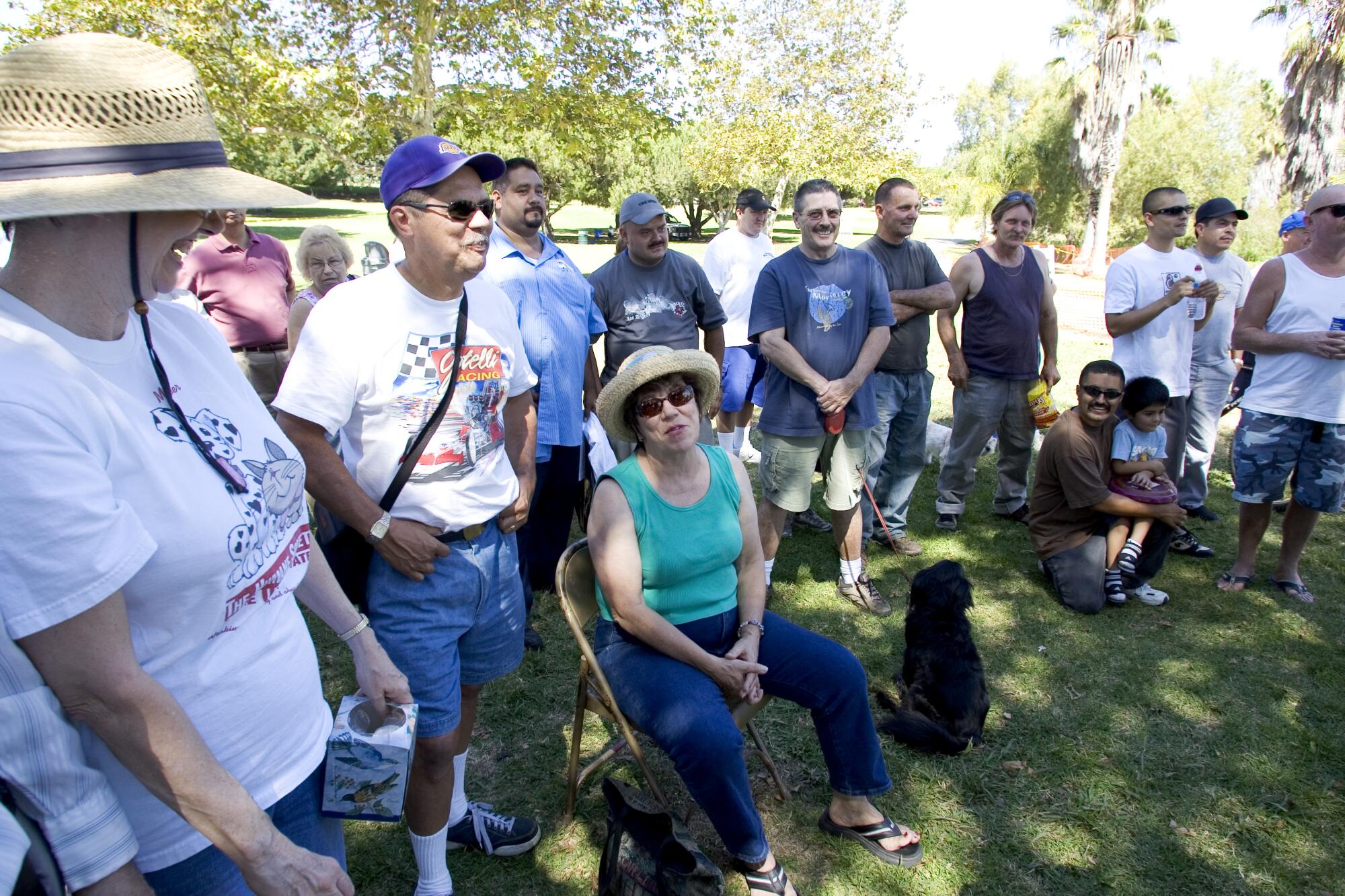
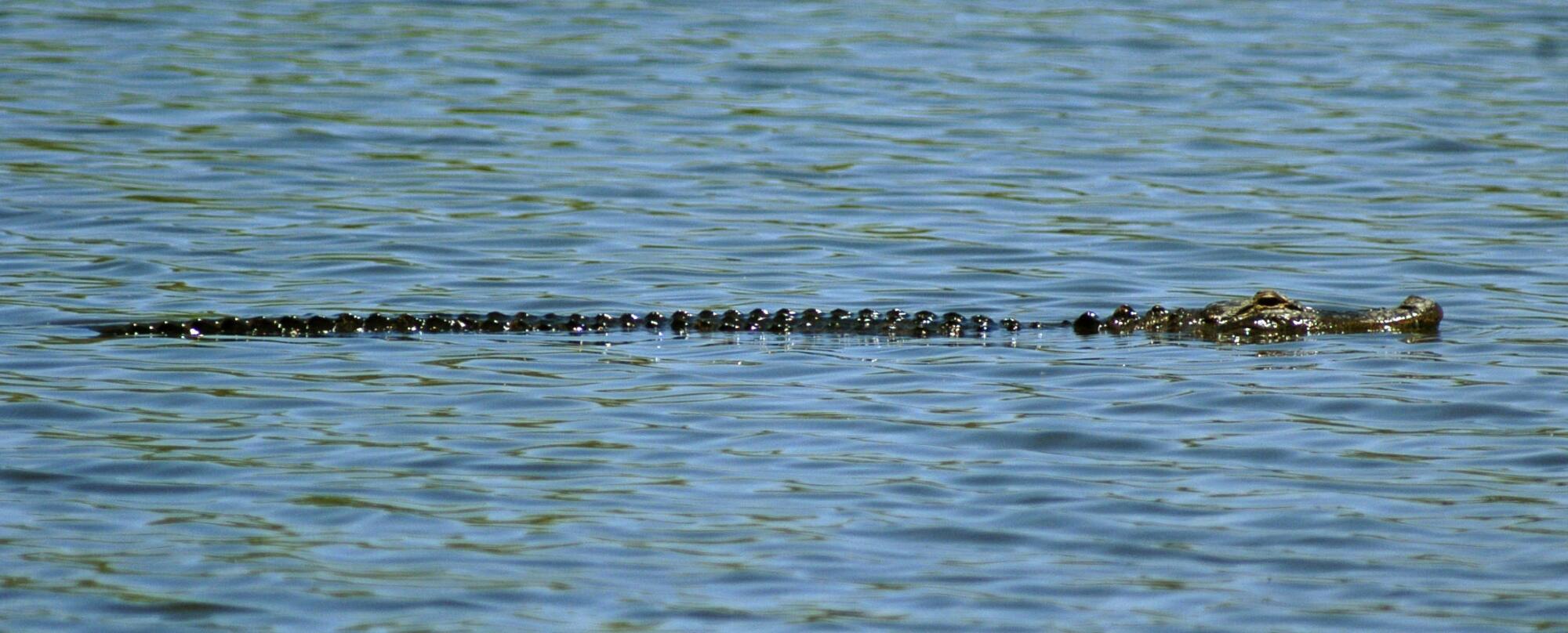
“It almost became a circus-like atmosphere,” said Los Angeles County Supervisor Janice Hahn, then a city councilwoman representing Harbor City. “Particularly in the evening, when Reggie could be seen poking his head out of the lake, they would bring lawn chairs and blankets.”
From a distance, the animal appeared to be about 6 feet long. It was hard to determine its species or sex. Authorities assumed it was a former pet, owned illegally and released into the waters when it got too big to handle.
“I mean, they’re cute when they’re babies,” said Jay Young, manager of Colorado Gators Reptile Park. “But so was I, and look how that turned out.”
Young was the first in a line of colorful gator wranglers who attempted to rescue Reggie from the park. News reports described him as a swashbuckling reptile expert who rolled into town in an alligator-tooth necklace.
“I had teeth in my hat too,” he said.

Young did not catch the alligator, and for a long time, neither did anyone else.
After Young came a team from Gatorland, an Orlando, Fla., theme park and wildlife preserve. They left empty-handed, and the city hired Thomas “T-Bone” Quinn, a self-proclaimed alligator wrangler from Louisiana. That offer was rescinded 24 hours later when it emerged that Quinn had no insurance and no credentials. (He was arrested on a parole violation three months later.)
News of L.A.’s elusive alligator reached Steve Irwin, the Australian zookeeper and star of the international hit TV series “The Crocodile Hunter.”
“It’s like a needle in a haystack, except the needle can move any direction at 30 miles an hour.”
— Jay Young, manager of Colorado Gators Reptile Park
Irwin flew out to Los Angeles on a scouting trip in summer 2006, Hahn said, and pledged to come back in the spring with his camera crew. Only weeks later, Irwin was killed by a short-tail stingray.
As chaos reigned at the lake, an anonymous tip led police to the two San Pedro men who admitted to releasing the animal into the lake after he outgrew enclosures at their homes. They gave the police some useful intel: They’d named the gator Reggie.
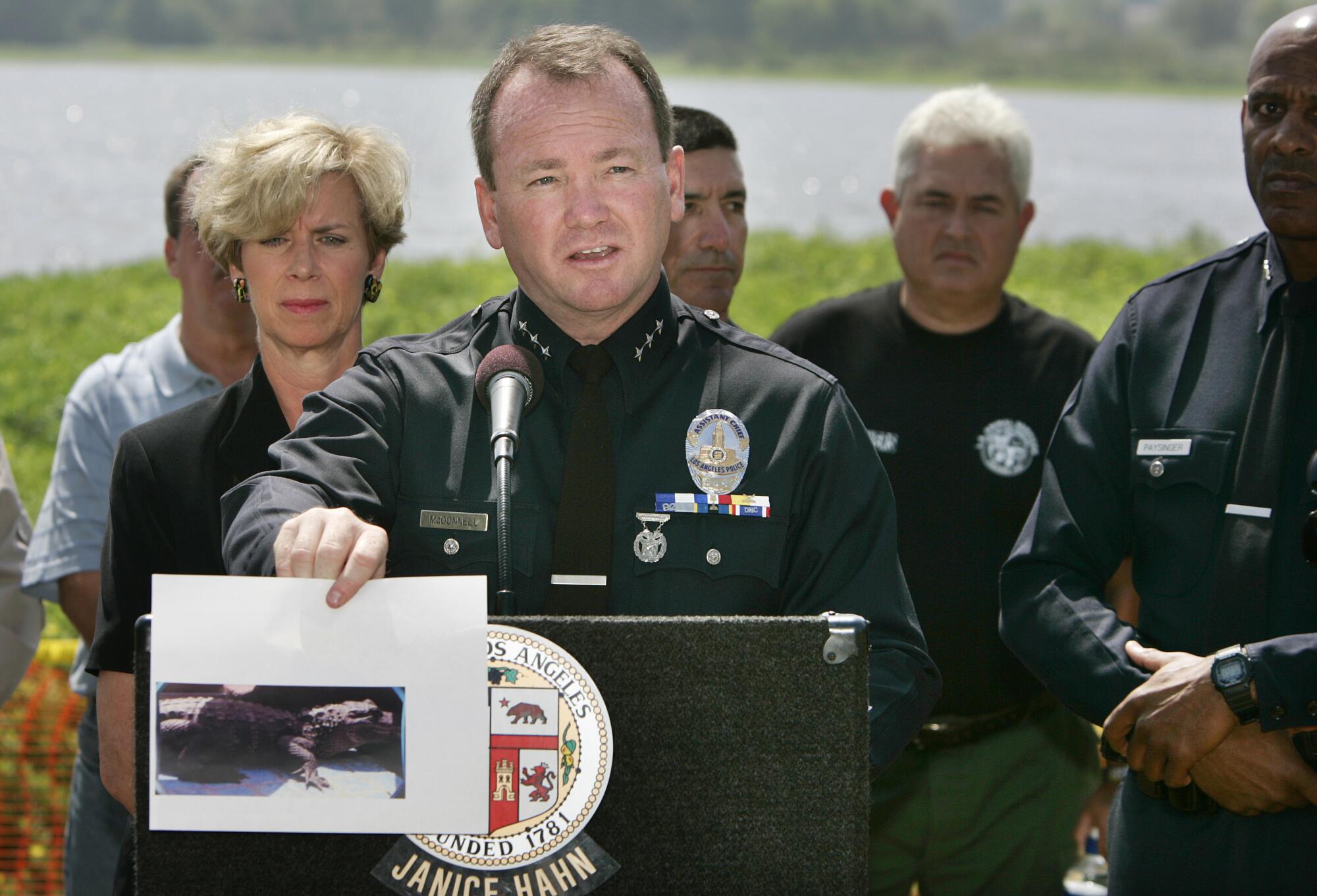
“We have animals at our park that we work with all the time. They know their name,” a Gatorland wrangler told a Times reporter. “We go out there and say, ‘Hey Bob, come here, Bob, over here,’ and he’ll come right up to you.”
It’s not that Reggie was an extraordinarily canny alligator, craftily outwitting his would-be captors. He was just a regular alligator, behaving as an alligator would in a setting far more suited to his needs than to those of his pursuers.
The odds were always in Reggie’s favor. The lake was the size of 15 Costcos. Food was abundant. If Reggie perceived a sound or movement as threatening, he simply swam away.
Lake Machado was so amenable to alligators that firefighters found a second gator in an adjacent flood channel during the search, one too small to be Reggie. It was quietly transferred to an animal sanctuary while the pursuit continued.
“It’s like a needle in a haystack, except the needle can move any direction at 30 miles an hour,” Young said. “The less commotion there is here, more likely we’re going to see it.”
But there was always commotion. The crowds around the lake were near-constant, which meant any gator-hunting efforts happened in full view of an audience. Media helicopters chopped overhead, scaring Reggie back into the water before wranglers could grab him.
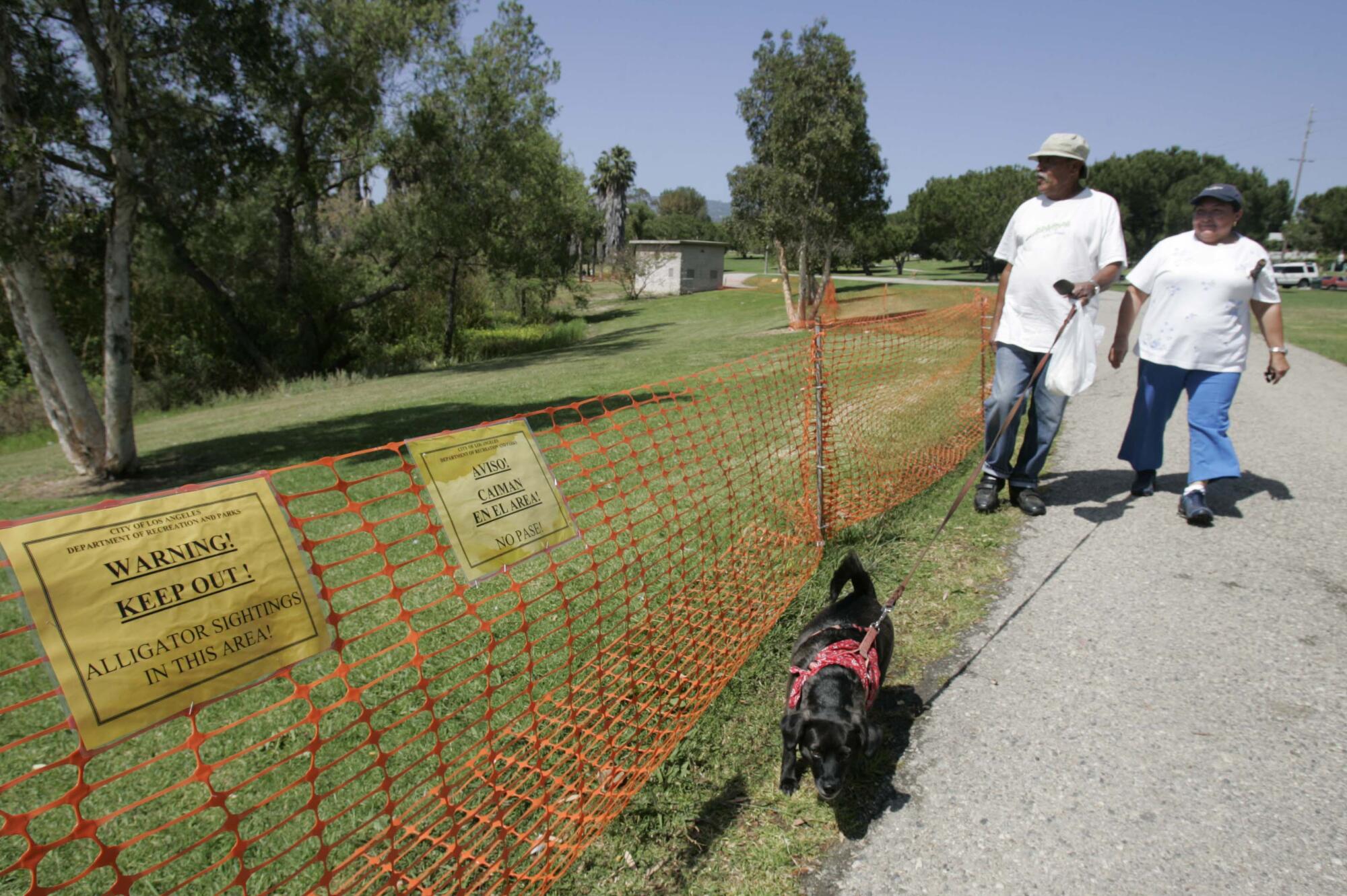
“It was the biggest fiasco I’d ever seen,” recalled Flavio Morrissiey, a member of the Gatorland crew. “It wasn’t that big! We would not consider that a threat. But I guess in California you would consider that news.”
The gator is captured
Winter came, and Reggie disappeared.
As temperatures fall, alligators’ metabolism plummets; they eat and move much less. They tend to spend this vulnerable period sheltering on land or underwater, where they can stay up to an hour without coming up for air.
On May 24, 2007, a few weeks after his first confirmed sighting in more than a year, Reggie crawled out of the water to sun himself on a bank just inside the chain-link fence. It was the best shot yet at his capture.
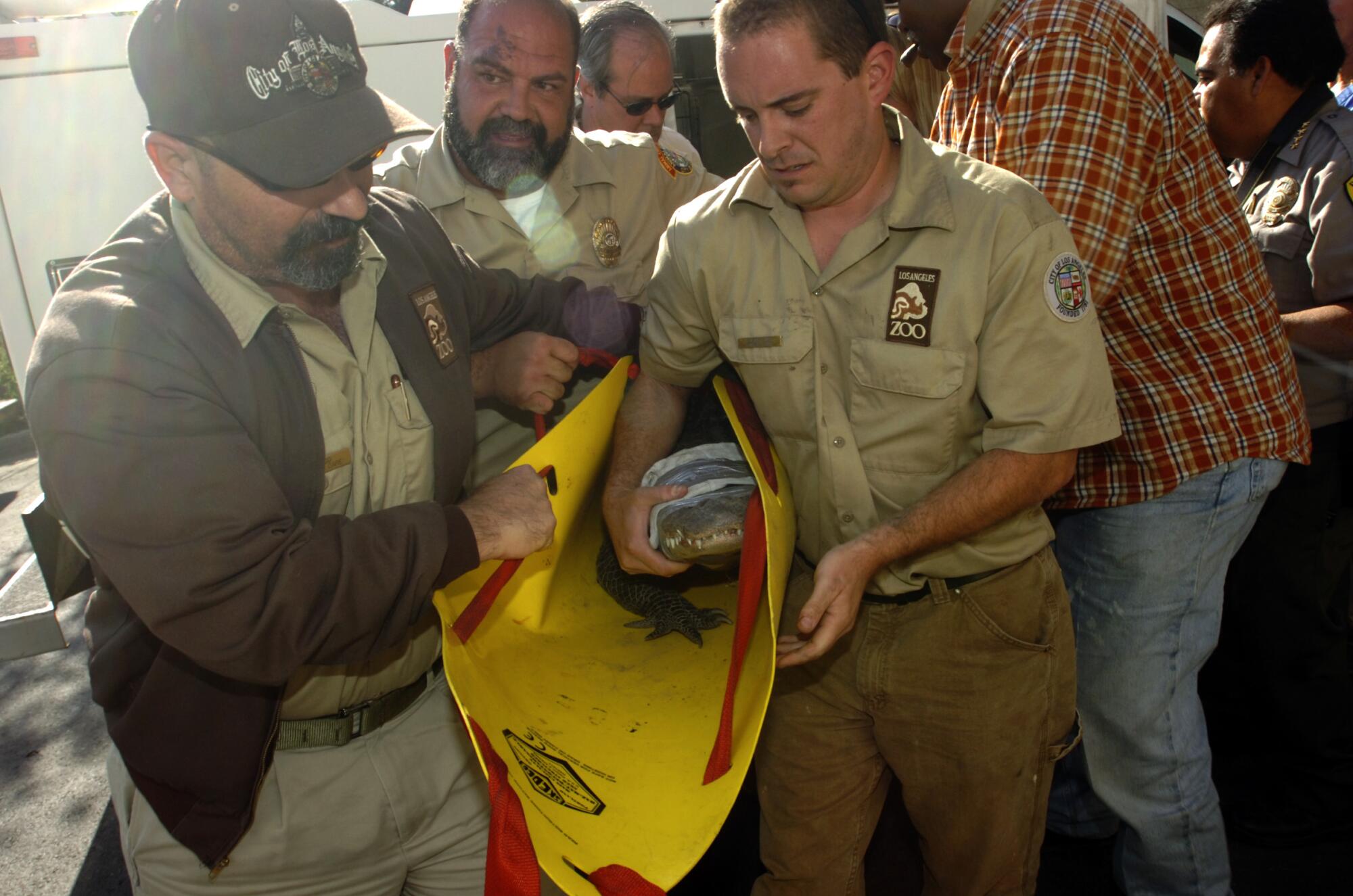
Recchio rushed to the park and found a 7½-foot-long alligator strong and lean from life in the wild. Reggie was cornered, and was as agitated as a young male alligator can be.
This, Recchio realized, was not a one-person job. He turned to a huddle of young, burly park employees.
“I said, ‘Have you ever watched ‘The Croc Hunter?’” And one of the guys goes, ‘Yeah,’” Recchio said. He had his wingman.
Recchio scaled the fence and secured Reggie’s head with a dog-catching pole lent to him by animal control. The park employee followed, and together they pinned the gator to the ground. With the help of a second daring park employee, Recchio duct-taped the gator’s jaws and wrapped a T-shirt around his eyes.
Then they lay there, three men and a gator, until firefighters arrived with a spine board sturdy enough to support the renegade reptile.
Reggie was loaded into an animal control truck for the 30-mile trip to the zoo. TV stations carried live footage of the journey.
The gator in captivity
Once at the zoo, Reggie was treated for parasites and placed into quarantine. Tests confirmed the long-held assumption that he was male. A vacant enclosure formerly occupied by flamingos was deemed an ideal alligator habitat.
On his first day before the public, Reggie was greeted by a cheering crowd. He crept into the wading pool and hid behind a rock.
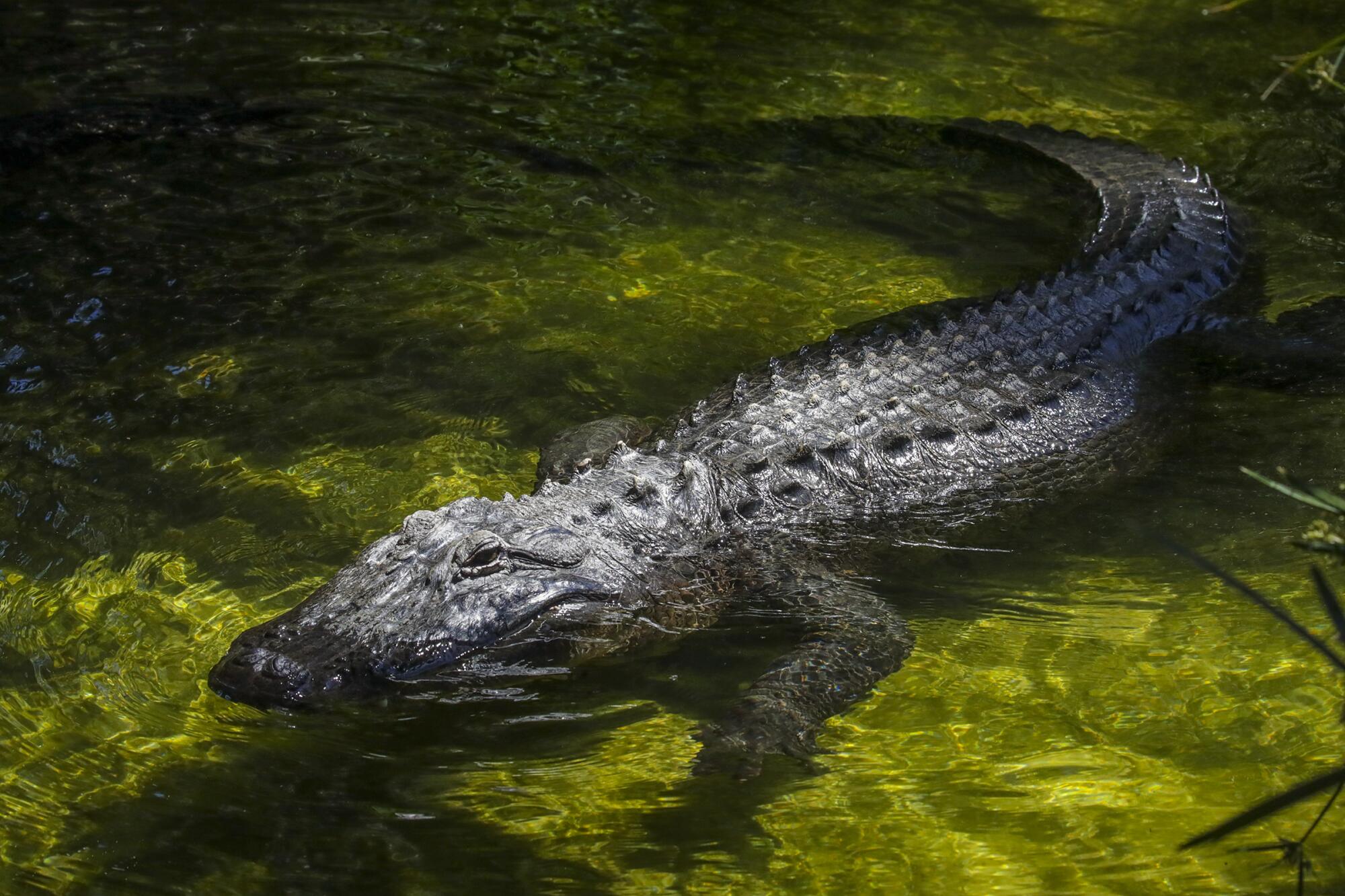
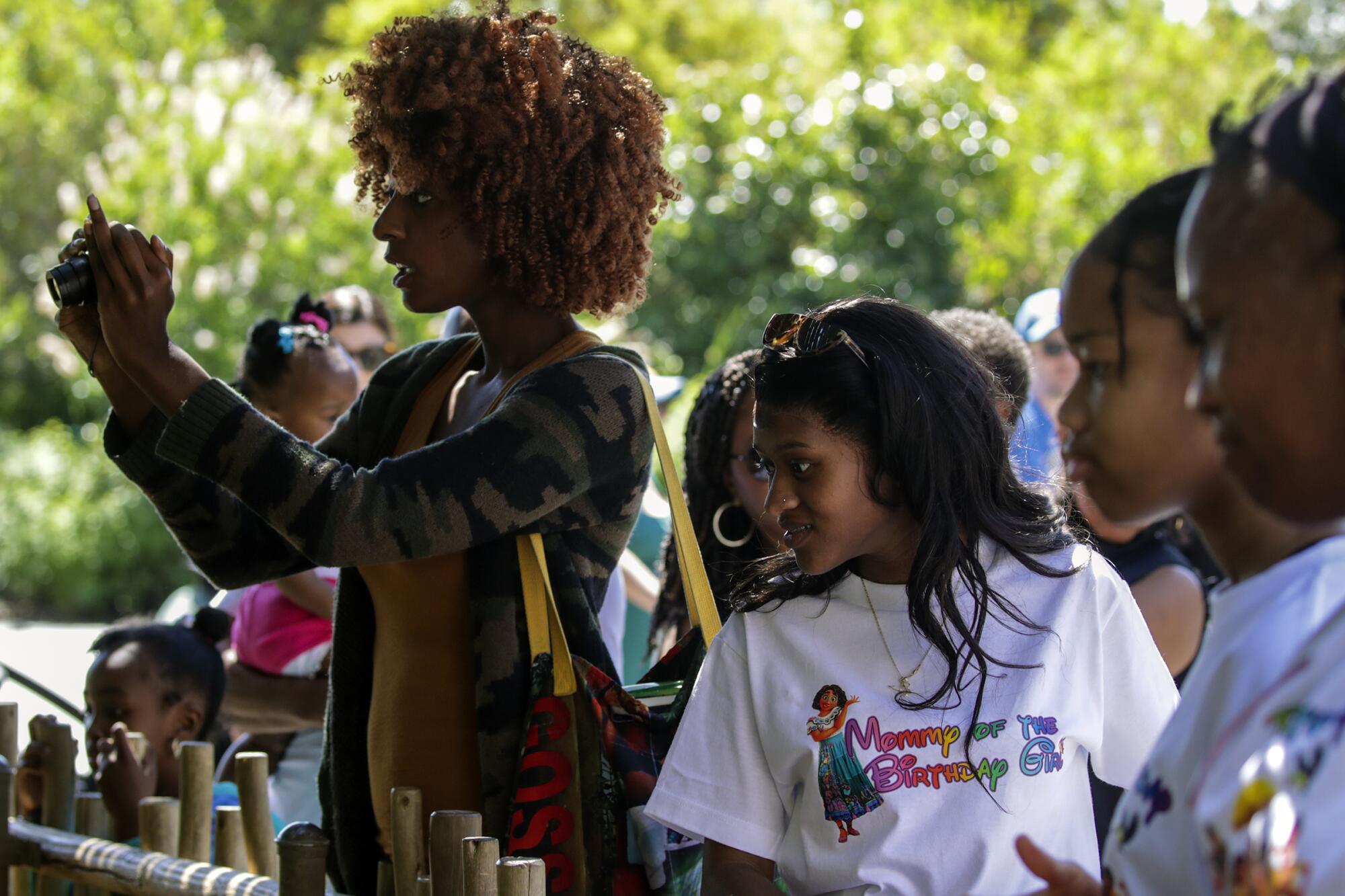
On the sixth day, he escaped.
Reggie had done in his new habitat what he most likely had done upon entering Lake Machado. He explored his surroundings. He looked for food and places to hide. He checked for other alligators that might want a piece of his territory.
It was August, and the coldblooded animal’s energy was at its peak. When Reggie came to a chain-link fence more than 4 feet tall — one that “alligators really shouldn’t be able to get over,” Recchio said — he started climbing.
Zoo staff making the morning rounds found an empty alligator enclosure around 7:30 a.m. “That’s obviously a big deal,” Recchio said.
Fortunately, alligators are a lot easier to track on land. Reptile curators followed the trail of tail-drag marks and gator footprints (five toes on the front feet, four webbed ones on the back) to a loading dock about 500 yards away where Reggie had paused to rest.
He soon returned to public view, behind a taller fence. And there he has remained.
In 2010, the zoo introduced Reggie to Cajun Kate, an American alligator previously located in a different enclosure. Newspapers celebrated the “life partners.”
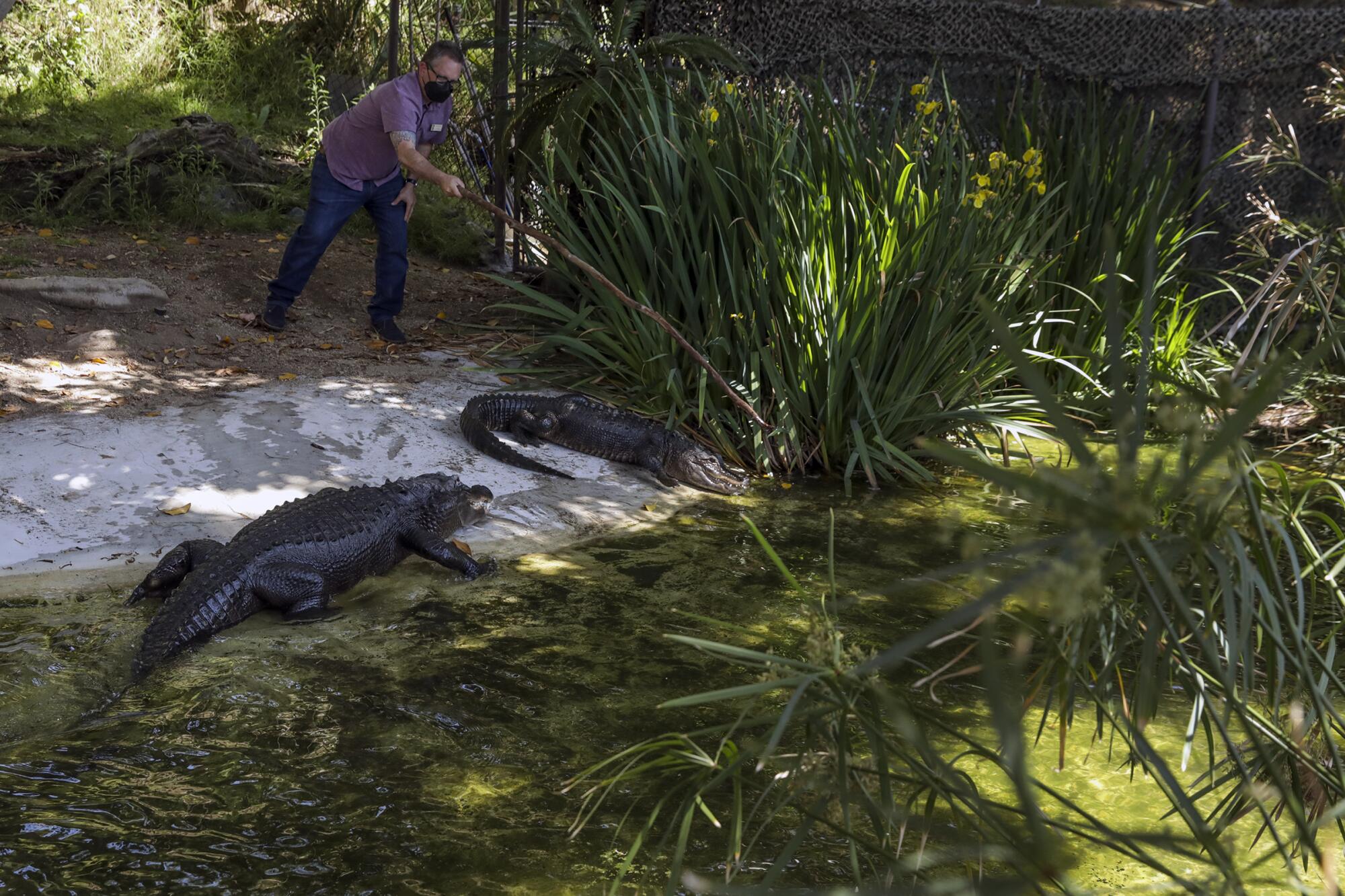
The reality of alligator relationships is a lot more complicated.
Alligators raised together in captivity can generally cohabitate peacefully. Attempting to introduce an adult alligator into another’s territory is almost always a disaster. “Reggie tried to kill her,” Recchio said, and Kate was sent to an animal sanctuary in Florida.
The zoo tried again in 2016 with Tina, an American alligator outgrowing her lodgings at the Pasadena Humane Society. Both animals showed aggressive behaviors to the other at first. But as winter approached and their metabolism slowed, they relaxed. When spring came around, the pair seemed comfortable with each other. Reggie likes Tina and hisses protectively at people who get close to her.
There’s a surplus of American alligators in the U.S., so the zoo is adamant that no babies will come from this pair. Were Tina to lay fertilized eggs, which she has never done, they would be removed and destroyed.
That said, Reggie and Tina are for the most part free to behave toward one another as any male-female pair of alligators would. No mating has been witnessed, but it can’t be ruled out. Reptiles often prefer to breed late at night or in the early morning hours.
Even the most public of alligators have private lives.
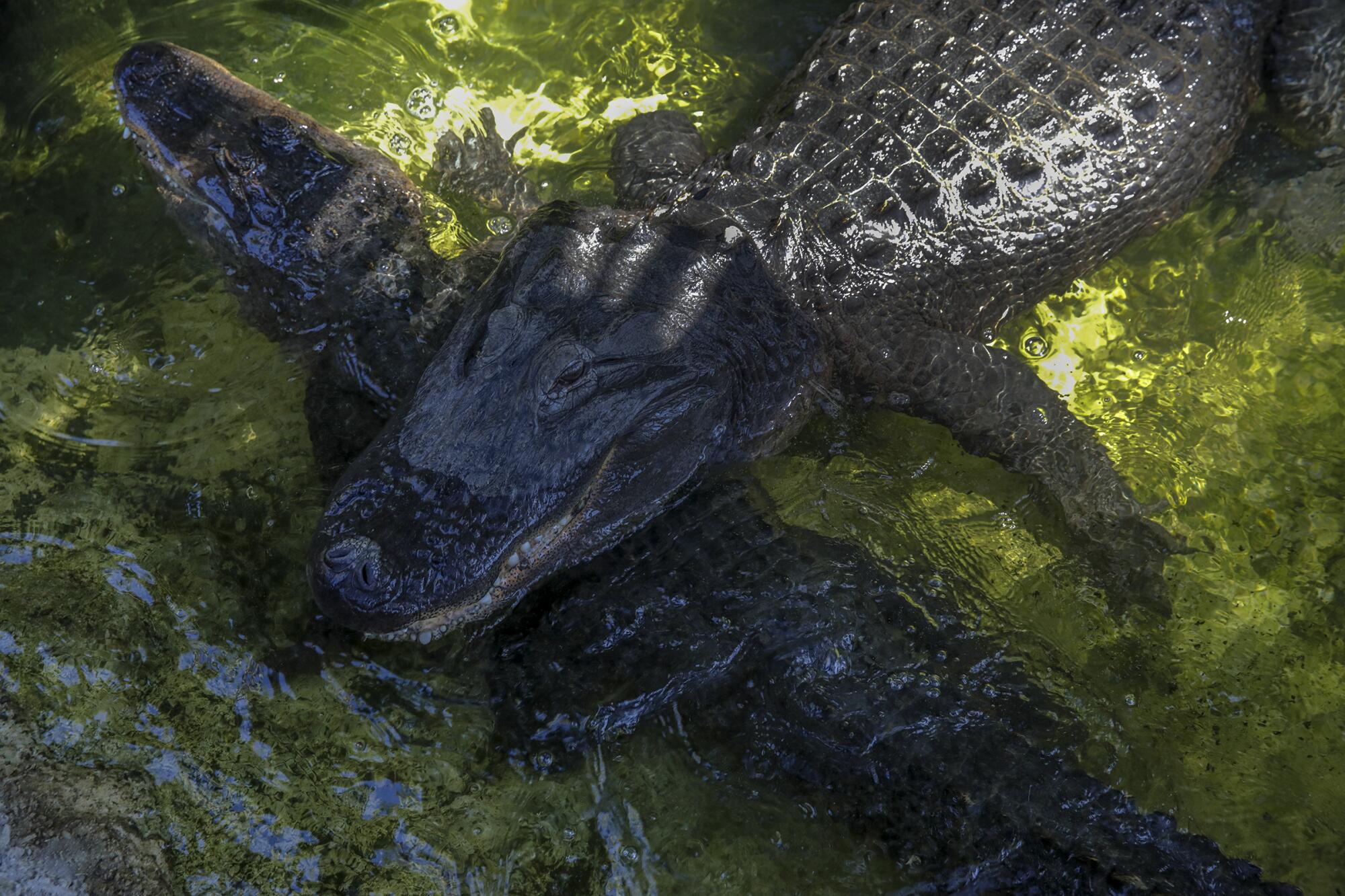
Coda
Reggie is now about 8 feet long and 250 pounds. He’s probably around 30 years old and could live 50 more years in captivity.
There are dozens of ways Reggie’s story could have ended, almost all of them bad. He could have been sickened or killed in the lake. He could have harmed a pet or a person. Do not expect things to turn out fine if you set an alligator loose in a public park.
Reggie never asked for any of this.
He is as alligator-like as alligators come, Recchio likes to say. The one thing that makes him different is that, for a while, he was a star in L.A.
Watch L.A. Times Today at 7 p.m. on Spectrum News 1 on Channel 1 or live stream on the Spectrum News App. Palos Verdes Peninsula and Orange County viewers can watch on Cox Systems on channel 99.
